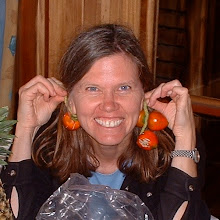One of my Unfinished Objects (UFOs) has become airborne again. One reason I put it aside is that before I could continue, I had to take my scissors to it. Cutting into something I've spent months knitting still makes me nervous even though I've done it quite a few times. However, I no longer hyperventilate (much).
A steek is a vertical set of stitches that are inserted in stranded knitting as a place to cut later. Since my Mayan Dreams sweater is to be a cardigan with sleeves, I had a steek the entire length of the front and steeks on each side beginning at the underarm.
The advantage of a steek is that one can knit around and around, always looking at the right side of the pattern. Doing a complicated two-color pattern back and forth would be mentally challenging as the pattern is difficult to see on the purl side. (Interestingly enough, most Peruvian stranded work is done from the purl side so they probably would think I do it the hard way working from the knit side.)
Many people sew along each side of the steek with a sewing machine before they cut it. Some add a crochet chain before they cut to stabilize the edge. But since I am very lazy, I do no preparation. This works for both Shetland yarn or the Kauni yarn I am using for this sweater because these yarns are so sticky they don't want to unravel. I proved this to myself by cutting a swatch and pulling at the edges. It's also the method recommended by Alice Starmore. By the way, I am so pleased that Alice Starmore's Book of Fair Isle Knitting has been reissued by Dover. It's the best book I've seen for both techniques and inspiration for Fair Isle knitting. Considering that I paid $24.95 in 1988 and the list price is again $24.95, it's quite a bargain.
I always make my steeks in alternating colors. That is, one stitch of color A, one stitch of color B, and so on, repeated until I have 8 or 10 stitches. Having these narrow columns of color makes it much easier to see where to cut. Once I have measured many times to make sure my armhole is the right depth, I cut. I am very careful that I am only cutting one layer of the sweater by holding some fingers under the top layer. In the picture, I'm using embroidery scissors but you can use any sharp scissors.
In the above picture I have paused to admire my neat cutting. After I cut the steeks I grafted the shoulders and picked up stitches around one of the arm holes. I pick up every row for 3 rows and then skip a row. (Most people have stitches that are slightly shorter than they are wide.)
Now I am knitting down on the first sleeve. Later I will trim my steeks to be two stitches wide and sew them with stitches on the inside that make Xs over the raw edge. This is an example on my Obsession sweater, also knit in Kauni. I've worn it a lot and washed it a couple of times with no problems with raveling.
Using steeks is a technique well worth learning if you want to do Fair Isle or other stranded knitting.
Subscribe to:
Post Comments (Atom)











3 comments:
I did a workshop with Alice Starmore a few years ago and she showed us the magical steek , but I had almost forgotten how it worked. I wondered if I would ever have the courage. With your explanation and pictures it doesn't seem so scary. Kauni is wonderful for projects like this, You used very nice colours! I'm currently making a two colour brioche scarf (from the Brioche stitch book by Nancy Merchant)in Kauni. The weather here in Holland is getting colder, so a warm scarf is very welcome.
Hello Carolina
I am so glad you popped you head up over at Q of the TC because this post here of yours is very very useful to moi right now. Great photos and excellent explanation. I am about a year new to Fair Isle and have become a bit obsessed by it - but I am yet to steek anything by you make it sound easy peasy.
Thank you.
Loani
As always, your blog entries are inspiring! I'm facing a quilt square for a friends and family baby quilt - and since I have embroidered anything since the 4th grade and my machine sewing skills are very poor, I'm slightly intimidated. However, watching you cut into the steak (a great new word for scrabble..) I think I can cut into my fabric too.
Post a Comment